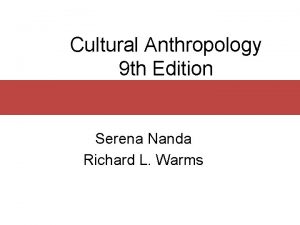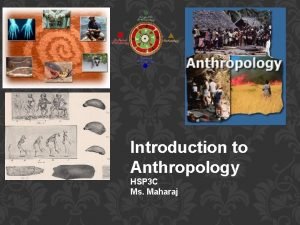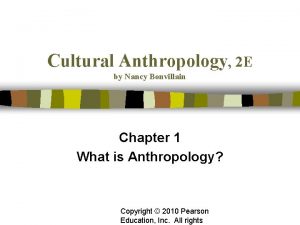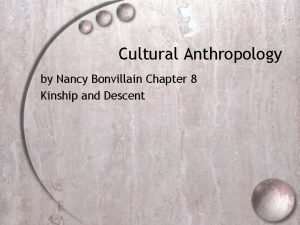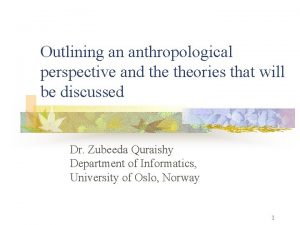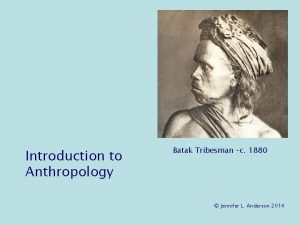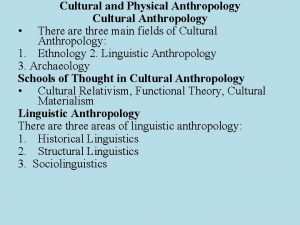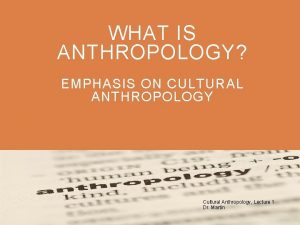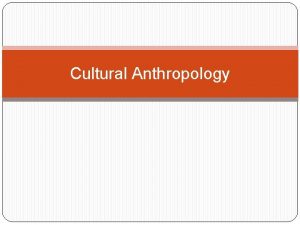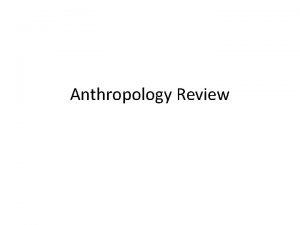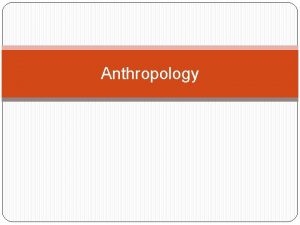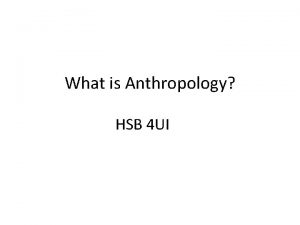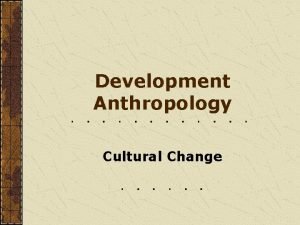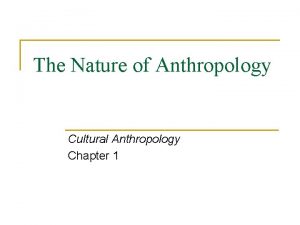Culture Counts A Concise Introduction to Cultural Anthropology




























































- Slides: 60

Culture Counts A Concise Introduction to Cultural Anthropology Serena Nanda Richard L. Warms © 2015. Cengage Learning. All rights reserved.

Chapter 10 Sex and Gender © 2015. Cengage Learning. All rights reserved.

Chapter Outline • • The Hijras: An Alternative Gender in India Sex and Gender as Cultural Constructions Cultural Variation in Sexual Behavior Male and Female Rites of Passage © 2015. Cengage Learning. All rights reserved.

Chapter Outline • • Power and Prestige: Gender Stratification Bringing it Back Home: Violence against Women and the Cultural Defense © 2015. Cengage Learning. All rights reserved.

The Hijras of India • • The hijras are an ambiguous gender role in India. Though born male, they are considered neither man nor woman. Hijras undergo an operation in which their genitals are surgically removed. Also includes hermaphrodites and transvestites © 2015. Cengage Learning. All rights reserved.

The Hijras of India • • Hijras consider the operation a rebirth carried out as an act of devotion to the Hindu Mother Goddess. After the operation, hijras are believed to incorporate the goddess’ powers of procreation. Their presence is required at weddings and at the birth of a child. Bless males with wishes for prosperity and virility Given traditional payment of money, cloth, and sweets Confirms their importance in Indian society Thought of as “man plus woman” © 2015. Cengage Learning. All rights reserved.

The Hijras of India • Hijras identify with an ambiguous gender role and figure in Hindu mythology and Indian culture. • Male deities who change into females temporarily • Deities with both male and female characteristics • Male religious devotees who dress and act as women in religious ceremonies © 2015. Cengage Learning. All rights reserved.

The Hijras of India How do the hijras differ from the stereotypical gender roles in the U. S. ? © 2015. Cengage Learning. All rights reserved.

Beyond Male and Female • • • India is one of many societies where cultural support is given to individuals who bridge the differences between male and female. Other societies include: • Mahu of Polynesia • Xanith of Oman on the Saudi Arabian peninsula • Two Spirit - Some Native American tribes • Kathoey of Thailand • Waria of Indonesia Most roles involve males who adopt women’s work, dress, and behavior, but there are the opposite as well © 2015. Cengage Learning. All rights reserved.

Two Spirits Two – spirit found in many Native American societies • Natives focused on their special gifts. Indian traditionalists, even today, tend to see a person’s basic character as a reflection of their spirit. Since everything that exists is through to come from the spirit world, androgynous or transgender persons are seen as doubly blessed, having both the spirit of a man and the spirit of a woman. Having two spirits makes them more spiritually gifted than the typical male or female • Often looked to them as religious leaders and teachers © 2015. Cengage Learning. All rights reserved.

Two Spirits • • • In the 20 th century, as homophobic European Christian influences increased among many Native Americans, respect for androgynous persons greatly declined; they were often forced to conform to standard gender roles. With the revitalization of Native American “red power” cultural pride since the 60 s, and the rise of gay and lesbian liberations movements at the same time, a new respect for androgyny started slowly re-emerging among American Indian people. Unfortunately, there is still a lot intolerance and even violence toward them © 2015. Cengage Learning. All rights reserved.

Sex and Gender • • Sex refers to the biological differences between male and female. Gender refers to the social classification of masculine and feminine. Gender is culturally constructed and extraordinarily diverse, as are the relationships between sex and gender. Genders are not limited to masculine and feminine in many cultures © 2015. Cengage Learning. All rights reserved.

Sex and Gender • • Every culture acknowledges the biological difference between male and female. • Cultures differ in the meanings attached to these categories, the supposed sources of the differences, and the relationship of these categories to other social and cultural factors • There is cultural variety in the: • Number of sexes and gender a society constructs • Ways in which sex and gender are defined Gender and gender relations are central to society © 2015. Cengage Learning. All rights reserved.

Sex and Gender as Cultural Constructions • • Cultural Construction - The idea that gender characteristics are not inborn but constructed within each culture as the result of historical, economic, and political forces acting within each culture Gender Ideology – the totality of ideas about sex, gender and the natures of men and women, including their sexuality, and the relations between the genders. © 2015. Cengage Learning. All rights reserved.

Sex and Gender as Cultural Constructions - Margaret Mead • • Developed the central anthropological principle that gender is a cultural construction created by societies Key findings in three New Guinean societies • Arapesh: Both sexes acted in ways Americans consider “feminine. ” • Mundugamor: Both sexes acted in ways Americans consider “masculine. ” • Tchambuli: Men acted in ways Americans consider “feminine” and women acted in ways Americans consider “masculine. ” © 2015. Cengage Learning. All rights reserved.

Margaret Mead • • Mead argued that society and culture create gender Great diversity in cultural definitions of masculine and feminine Gender Ideology – the totality of ideas about sex, gender, the natures of men and women, including their sexuality, and the relations between genders Gender ideology is a core element in gender stratification (ways in which gendered activities and attributes are differentially valued and related to the distribution of resources, prestige, and power in a society). © 2015. Cengage Learning. All rights reserved.

Creative Expression of Gender • • • Deep Play activities that reinforce culturally constructed gender values Football, cockfighting, rugby, bullfighting • A variety of cultural performances display both conscious and unconscious cultural themes relating to gender ideology and personal gender identity • Games and sports • Heightens emotions, displays compelling aspects of social structure and culture, and reinforces culturally constructed gender identities © 2015. Cengage Learning. All rights reserved.

Bullfighting in Spain • • From an emic point of view, bullfighting is an aesthetic ritual expressing male gender value. Matador symbolizes the role of honorable male Point of bullfight is not to simply kill a bull; that would be easy and lack cultural meaning The ritualized violence is carried out with grace, skill, and courage. The male matador is the central element; he should be able to kill the bull quickly with elegance and poise and distinguish himself as a “man of honor. ” Performance allows the matador a chance to transcend the animal nature of man and exhibit poise, self-control, and honor. Women are now entering bullfighting © 2015. Cengage Learning. All rights reserved.

Cultural Variation in Sexual Behaviors • • • Human sexual activity is patterned by culture; culture patterns the habitual responses of different people to different parts of the body Cultures vary in what is considered erotic. • Before the Tahitians learned to kiss from the Europeans, they began sexual intimacy by sniffing. • Alaskan Inuit adults sniff the hollow in another’s cheek for intimacy. Sexual foreplay is culturally diverse • The Trobriand Islanders inspected each other for lice if they felt fond of each other; or they may gather wild foods together. • Europeans might go on a picnic © 2015. Cengage Learning. All rights reserved.

Cultural Variation in Sexual Behavior Homosexuality • • Appropriate sexual partners differ among cultures Sambia (New Guinea) - practice homosexual sex as a core ritual to male initiation; considered essential for the development of adult masculinity Believe women are naturally fertile and mature without external aid Women are viewed as dangerous creatures that pollute men, deplete them of the masculinity substance, and are inferior in every way except for reproduction capabilities © 2015. Cengage Learning. All rights reserved.

Cultural Variation in Sexual Behavior • • • Believe males cannot attain puberty or become “strong men” without semen; believe males do not naturally produce semen so it must be externally and artificially introduced into the body Attained by magical ritual treatments, which include homosexual fellatio during the boy’s initiations, as a way of boys consuming semen from adult men; repeated inseminations confer on young boys the reproductive competence that results in manliness, necessary to become a vigorous warrior and father As adults, these men engage in heterosexual marriages © 2015. Cengage Learning. All rights reserved.

Cultural Variation • • Ancient Greeks elevated homosexuality as superior to heterosexuality The many cultures in which same-sex relationships are views as normal variants of human sexuality strongly contrasts with modern Europe and the United States, where the dominant cultural ideology is that heterosexuality is considered essential to masculine identity © 2015. Cengage Learning. All rights reserved.

Cultural Variation in Sexual Behavior • • Sexual norms affect sexual behavior. Cultures differ in: • Age that sexuality begins and ends • Ways people make themselves attractive • Importance of sexual activity • Sexual variation according to gender © 2015. Cengage Learning. All rights reserved.

Cultural Variation in Sexual Behavior - Ireland: Inis Beag Society • • • Described as “one of the most sexually naïve of the world’s societies. ” Culturally patterned sexual repression Sex is never discussed when children are near; children receive no sexual instruction Adults believe after marriage “nature will take its course” Women should not enjoy sexual activity; but to refuse sex is a mortal sin (Roman Catholic) Ignorant of female capacity for orgasm (deviant behavior) Absence of sexual foreplay Sexes are kept strictly separated. There is absence of premarital sex due to belief that sexual activity weakens a man; also a lot of celibate males Marriage occurs late in life. © 2015. Cengage Learning. All rights reserved.

Cultural Variation in Sexual Behavior Polynesia: Mangaia • • Sexual intercourse is major interest and highly valued. Elders of group teach sexual information to boys and girls at puberty Adolescent boys are given sexual instruction and an experience with a mature woman in the village (he is now a man) Sexual jokes, expressions, and references are common However, in public sex segregation is the norm Practically every girl and boy has had intercourse before marriage. Both men and women are expected to enjoy sex © 2015. Cengage Learning. All rights reserved.

Gender Ideology and Women’s Sexuality • • • Gender ideology is a cultural product • Most societies view males and females as distinct regarding sexuality. • These differences are often used to justify men’s control over women’s sexuality and become a basis for gender stratification Gender stratification – constraints on women’s lives and discrimination against women (e. g. , male control over social institutions; seclusion of women; control over women’s dress…) • Cultural emphasis on honor and shame for females • Often leads to violence toward women Society’s control of female sexuality is often inscribed on female bodies: Female circumcision (Africa), Chinese footbinding, Sati (women burning themselves on husbands’ funeral pyres) © 2015. Cengage Learning. All rights reserved.

Gender Ideology Male control over social institutions related to sexuality • Law • Organized religion • Dress Codes • Marriage • Divorce • Adultery • Concepts and treatment of rape • Abortion © 2015. Cengage Learning. All rights reserved.

Gender Ideology Society’s control over female sexuality is often inscribed on female bodies: • Female circumcision • Chinese footbinding • Sati (women burning themselves on husbands’ funeral pyres) (now outlawed in India) • Anorexia and eating disorders in the West © 2015. Cengage Learning. All rights reserved.

The Hijab • • Muslim gender ideologies and practices require women to have modest dress, but vary in different Islamic cultures ; different interpretations of Qur’an Hijab – head covering To non-Muslims - Sign of oppression making them invisible and restricting their freedom of choice To many Muslim women – a liberating garment that forces world to see them as more than sexual objects and establishes their identity as Muslims © 2015. Cengage Learning. All rights reserved.

The Hijab Cultures differ in what is acceptable • Saudi Arabia – must wear face veil • Egypt – most wear headscarves • Afghanistan (Taliban rule) – must wear burka • France – headscarves banned in public institutions and public schools; last year banned burkini bathing suits • Germany is planning to ban full faced veils • American commitment to individual freedom of religious practice has made Islamic dress less of an issue here © 2015. Cengage Learning. All rights reserved.

Male and Female Rites of Passage Rites of passage – a ritual which moves a person from one social status to another • Male Rights of Passage: • Reinforce social order • Culturally validate male relationship, solidarity, and sometimes dominance • Change of status from child to adult • Involve an extended period of separation – learn beliefs, skills, and knowledge • Painful practices to mark formal transition • Difficult and dangerous tasks • Separates boys from identification with mother © 2015. Cengage Learning. All rights reserved.

Manhood Puzzle • • • Manhood Puzzle (David Gilmore) - widespread male need to publicly test and prove one’s manhood; question of why masculinity is viewed as problematic status to be won Gilmore suggests that cultural patterns of “proving manhood” help ensure men will fulfill social roles This, he argues, is at the heart of the “macho” masculine role and accounts for its intensity, near universality, © 2015. and. Cengage persistence. Learning. All rights reserved.

Female Rites of Passage • • More widespread than male rites Generally performed at menarche (first menstruation) Research indicates much cross-cultural variability. • Sometimes the initiate is isolated from society; sometimes she is the center of attention. • Some rituals are elaborate and take years to perform; others are performed with little ceremony. Performs many social functions: • Publicly announce girl’s change of status and her acceptance of new role • Transmits cultural knowledge on being responsible adult • Channels sexuality into adult reproduction © 2015. Cengage Learning. All rights reserved.

Power and Prestige: Gender Stratification • • • Gender Stratification - the ways gendered activities and attributes are related to the distribution of resources, prestige, and power in a society Is male dominance universal? If so, why? Anthropologists look at many factors: • Social and cultural significance of women’s roles • Economic contribution • Sources of women’s power and influence • Development of women’s identities • Changes in all these dimensions through history © 2015. Cengage Learning. All rights reserved.

Power and Prestige: Gender Stratification • Public/Private Dichotomy • Theory that female subordination is based on women’s universal role as homemakers • Gender system in which women’s status is lowered by their cultural identification with the home and children (private). • Men are identified with prestigious roles (public). • Characteristic of highly gender-stratified 19 th-century capitalist societies • Less applicable to small-scale societies where family and economics not as easily separated © 2015. Cengage Learning. All rights reserved.

Power and Prestige • • Peggy Sanday Male dominance may not be universal, but no women in any society hold the extremes of dominance that men do Occurs in connection with ecological stress and warfare; survival depends on male actions Where the survival of the group rests more on male actions, such as warfare, women accept male dominance for the sake of social and cultural survival • © 2015. Cengage Learning. All rights reserved.

Gender Relations: Complex and Variable • • Patriarchy: Male-dominated society in which men hold all important public and private power Matriarchy: Female-usually believed that dominated society in which women hold all important public and private power – but more equality between men and women © 2015. Cengage Learning. All rights reserved.

Gender Relations • • Matriarchy • Never exists in extreme dominance the way patriarchy can • Matriarchies are more equal but not mirror opposite of patriarchy • More recognition today that female power does find a place in many societies With greater understanding of the complexity of gender stratification systems, anthropologists today have moved from question of whether male dominance is universal to explanations of gender stratification in different societies © 2015. Cengage Learning. All rights reserved.

Gender Relations in Foraging Societies • • Early anthropologists viewed male hunting in foraging societies as the major source of food supply, providing basis for male domination Contemporary anthropologists have modified this view to show these societies were often egalitarian due to contributions of women © 2015. Cengage Learning. All rights reserved.

Tlingit of the Northwest Coast • • • Gender relations were egalitarian. Women and men could achieve prestige through their own efforts. Sexual division of labor was not rigid (PUBLIC PRIVATE DICHOTOMY) Women often acted as negotiators and handled the money for longdistance trade. (PUBLIC. PRIVATE DICHOTOMY) Some women were heads of clans or tribes. Ideal marriage was between a man and woman of equal rank. Roles were structured based on ability, training, and personality rather than gender. Egalitarianism continues to be core cultural value Modernization has expanded women’s roles. © 2015. Cengage Learning. All rights reserved.

Gender Relations in Horticultural Societies • • • Less autonomy and power than in foraging societies Varies cross-culturally • Iroquois versus Yanomamo High degree of segregation between the sexes • Example: Mundurucu (South America) • Adolescent boys are initiated and moved permanently into a men’s house. • Women and children live separately and receive visits from men. • Men’s cults are secretive and exclude women. • Men’s house is most imposing structure in village © 2015. Cengage Learning. All rights reserved.

Gender Relations in Horticultural Societies • Solidarity of women in horticulture societies is based on cooperation in domestic life and strong bonds among female kin • Example: Sub-Saharan Africa • Blood bonds between generations are most important • Women’s most important tie is with son • Both men and women use their natal ties to gain access to land, establish support in marital disputes, and perform ritual activity © 2015. Cengage Learning. All rights reserved.

Gender Relations in Horticulture Societies • • • Impact of outside influences greatly impacted women’s roles and status in society, especially European expansion. Women’s roles declined as indigenous economies shifted from subsistence-based to cash cropping for world market. • Example: Nukumanu (Polynesia) • Economy was subsistence-based with women gathering taro, cooking, and focused on domestic duties, while men gathered over longer distances and constructed thatch buildings. • Women’s power came from matrilineal control of land matrilocal residence; men’s power came from economic contribution and political roles. • German colonial occupation began in 1880 s: • Cash-cropping of copra began to replace taro. • Women’s status declined, as they contributed less to the domestic economics. • Men’s status increased, as they played greater economic and political roles. • Sexual segregation increased vastly; male-female tensions increased Today, educational opportunities allow women to obtain more equality. © 2015. Cengage Learning. All rights reserved.

Gender Relations in Pastoral and Agricultural Societies Pastoral and agricultural societies tend to be male dominated, though there is some variation. • In pastoral societies women’s status depends on the degree to which the society combines herding with cultivation, its specific historical situation, and the diffusion of cultural ideas. • Women’s contribution to food supply is small bc men have the strength to work with the animals • Not a rigid distinction between public and private spheres • Men predominantly own and control all livestock (but animals may be jointly held by men and women). • Men have economic, social, and cultural dominance. • Kinship • Defense through warfare CAN VARY CROSS -CULTURALLY • © 2015. Cengage Learning. All rights reserved.

Gender Relations in Pastoral and Agricultural Societies • • Tuareg (Central Sahara) Women have high prestige and substantial influence. Matrilineal society; herd camels, sheep, goats, and donkeys. • Inheritance through female line Women have considerable rights and privileges. • do not veil their faces. • can own property. • have freedom of movement. • is only minimal separation from men. • have social and economic independence. • have freedom of choice in sexual involvements. © 2015. Cengage Learning. All rights reserved.

Gender Relations • • Tuareg Today, this is being lost due to: • Tuareg migration. - men go to cities • Urban environments have different roles for men and women. • Contact with more patrilineal societies • However, cities may provide more opportunities and freedom for the women © 2015. Cengage Learning. All rights reserved.

Gender Relations in Pastoral and Agricultural Societies • • • Due to the use of plows, there is a dramatic drop in females’ involvement in food production overall in agricultural societies. Plow agriculture diminishes direct female contribution. Some cultural variation exists (women have higher productive value in wet rice cultivation). In general, women lose social status with agriculture. • Less economic contribution • Increasing isolation in domestic work • Increasing numbers of children • Paid lower wages than men when employed at all. • They are concentrated in labor-intensive aspects of agriculture (weeding, transplanting, harvesting). With transition to a cash economy, women’s status sinks further. © 2015. Cengage Learning. All rights reserved.

Gender Relations • Women’s status in modern stratified societies varies greatly and is affected by economic development, political ideology, and globalization. • In many cases, women may benefit more than men. • In Mata Chico, Peru, in the 1930 s, the only way for women to get access to land was to marry. • By the 1980 s, Peru was urbanized and many occupations were available to men and women. • Since women could support themselves and their children, they remained single longer and, in some cases, chose not to marry. © 2015. Cengage Learning. All rights reserved.

USING ANTHROPOLOGY Intervention and programs for economic development often ignore women while increasing male productivity • They lead to greater gender inequality. • They may lead to greater levels of domestic violence. • If anthropologists are involved, more attention may be paid to women’s roles • Ann Dunham – fieldwork in Indonesia • Challenged the common notion that roots of poverty were the poor themselves • Underdevelopment in these villages resulted from scarcity of capital • Set up credit cooperatives for Indonesian women for marketplace • Food sellers, factory workers, hand-loom weavers, shopgirls • Was successful and resulted in increased prestige, income, and autonomy © 2015. Cengage Learning. All rights reserved.

Gender Relations in the Global Economy • • • In the United States, the view that women should be excluded from all but domestic and child rearing roles has been culturally dominant, and remains so among many Americans. More women than men may go to medical school, but they tend to take on less prestigious specializations after graduation Continued gender stereotyping and discrimination Domestic violence and sexual harassment are significant problems based on a cultural pattern that values control over women. Struggle for reproductive autonomy (women’s right to end pregnancy) • Cultural debate about the meaning of life, the nature of women, and limits of gender equality © 2015. Cengage Learning. All rights reserved.

Gender Relations • • • Sweden real effort to blur gender differences (avoid pronouns like him or her) and library contains few classic fairy tales like Cinderella and Snow White which are full of gender stereotypes Boys and girls are allowed to cry Neither sex gets in trouble for doing activities typically associated with the other gender Swedish government realizes that erasing gender stratification must begin early © 2015. Cengage Learning. All rights reserved.

Quick Quiz © 2015. Cengage Learning. All rights reserved.

1. Which of the following does NOT describe anthropologists’ involvement in studies of gender? a) Examination of evolutionary and historical changes in gender relations b) An exclusive focus on women, children, and issues specific to women's lives c) Examination of how gender relations interrelate with other aspects of a society and culture © 2015. Cengage Learning. All rights reserved.

Answer: b • The following does not describe anthropologists’ involvement in studies of gender: • An exclusive focus on women, children, and issues specific to women's lives © 2015. Cengage Learning. All rights reserved.

2. Anthropologists refer to the observation that in nearly all world cultures men test and prove their manhood as: a) the androgyny complex. b) the "manhood puzzle. ” c) androcentrism. d) initiation. e) the public/private dichotomy. © 2015. Cengage Learning. All rights reserved.

Answer: b • Anthropologists refer to the observation that in nearly all world cultures men test and prove their manhood as the "manhood puzzle. ” © 2015. Cengage Learning. All rights reserved.

3. Women’s role in the economy of a society: a) b) c) d) e) may be improved by the introduction of new technology. often changes, so they have more leisure time to spend with their children. is often underestimated, so their status declines if machine technology is added. improves with technology and with being paid in cash for their hard work. diminishes as men take wage-labor jobs. © 2015. Cengage Learning. All rights reserved.

Answer : c • Women’s role in the economy of a society is often underestimated, so that their status declines if machine technology is added. © 2015. Cengage Learning. All rights reserved.

4. To say gender is “constructed” means: a) most cultures have few expectations about behavior as it relates to gender. b) masculine and feminine have different meanings (and associated behaviors) in different cultures. c) gender differences are actually superficial, given other concerns of people’s lifestyles. d) societies have developed ideas of two or more genders in planning their way of life. © 2015. Cengage Learning. All rights reserved.

Answer: b • To say that gender is "constructed" is to say that masculine and feminine have different meanings (and associated behaviors) in different cultures. © 2015. Cengage Learning. All rights reserved.
 A concise introduction to linguistics
A concise introduction to linguistics Cultural anthropology examples
Cultural anthropology examples Hsp3c
Hsp3c Cultural anthropology nancy bonvillain
Cultural anthropology nancy bonvillain Cultural anthropology nancy bonvillain
Cultural anthropology nancy bonvillain Cultural anthropology definition
Cultural anthropology definition Cultural materialism anthropology
Cultural materialism anthropology Introduction to anthropology psychology and sociology
Introduction to anthropology psychology and sociology Anthropology psychology and sociology
Anthropology psychology and sociology What is anthropology
What is anthropology Anthropological perspective and orientation
Anthropological perspective and orientation Introduction to anthropology
Introduction to anthropology Trait vs state
Trait vs state Examples of pretentious diction
Examples of pretentious diction Concise binary object representation
Concise binary object representation Concise writing style
Concise writing style Concise history of western music 5th edition
Concise history of western music 5th edition Concise thesis statement
Concise thesis statement Short but concise
Short but concise Objective and concise
Objective and concise Being concise
Being concise Precise vs concise
Precise vs concise Vigorous writing is concise
Vigorous writing is concise Concise definition
Concise definition Disaster management in libraries and information centres
Disaster management in libraries and information centres Development is relatively orderly.
Development is relatively orderly. Vigorous writing
Vigorous writing Concise precise
Concise precise Concise style
Concise style Material culture example
Material culture example Sociologists define a symbol as
Sociologists define a symbol as Batch culture vs continuous culture
Batch culture vs continuous culture Continuous culture and batch culture
Continuous culture and batch culture Characteristics of collectivism
Characteristics of collectivism American vs indian culture
American vs indian culture Stab and stroke culture
Stab and stroke culture Folk culture and popular culture venn diagram
Folk culture and popular culture venn diagram A sub-culture group
A sub-culture group Examples of mass culture
Examples of mass culture Anerobic media
Anerobic media Homework due today
Homework due today Inert organizational culture
Inert organizational culture Lawn culture method
Lawn culture method Robertson cooked meat medium
Robertson cooked meat medium Quality culture changing hearts minds and attitudes
Quality culture changing hearts minds and attitudes Surface culture deep culture and esol
Surface culture deep culture and esol Steve ward calm counts
Steve ward calm counts Tdot traffic count
Tdot traffic count Alcohol metabolism
Alcohol metabolism It consists of numbers representing counts or measurements
It consists of numbers representing counts or measurements Quality counts background checks
Quality counts background checks Cry unit
Cry unit Reading inventory scores
Reading inventory scores Bias through statistics and crowd counts
Bias through statistics and crowd counts Every opportunity counts
Every opportunity counts Make every opportunity count
Make every opportunity count Bias through statistics and crowd counts
Bias through statistics and crowd counts Glasgow counts
Glasgow counts Sig fig rules
Sig fig rules Practice competitions for mathcounts
Practice competitions for mathcounts Semcog traffic counts
Semcog traffic counts

